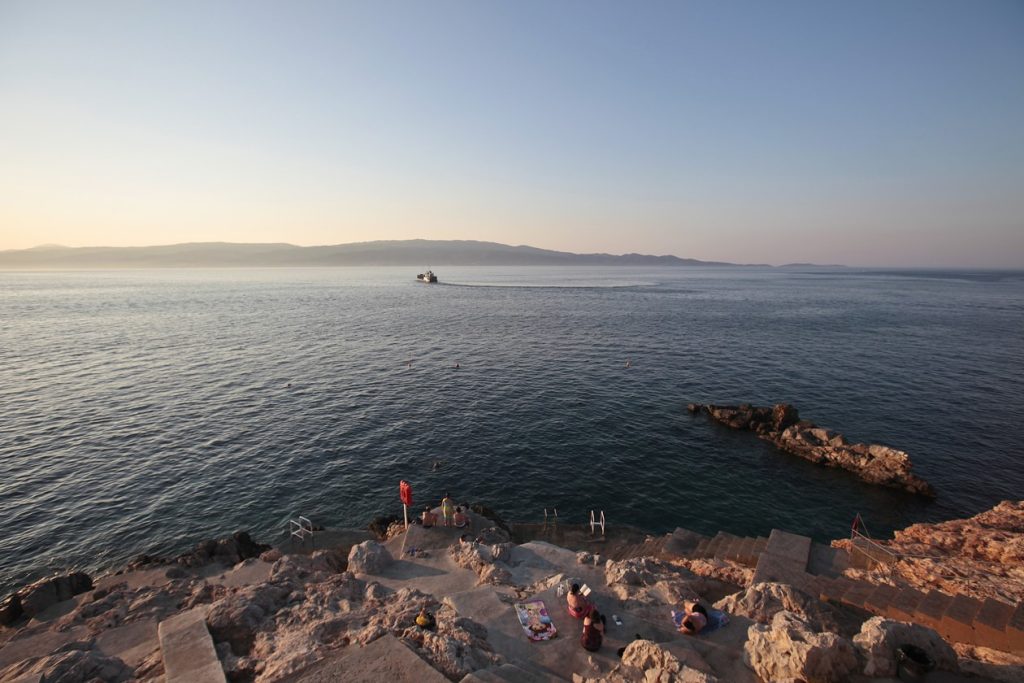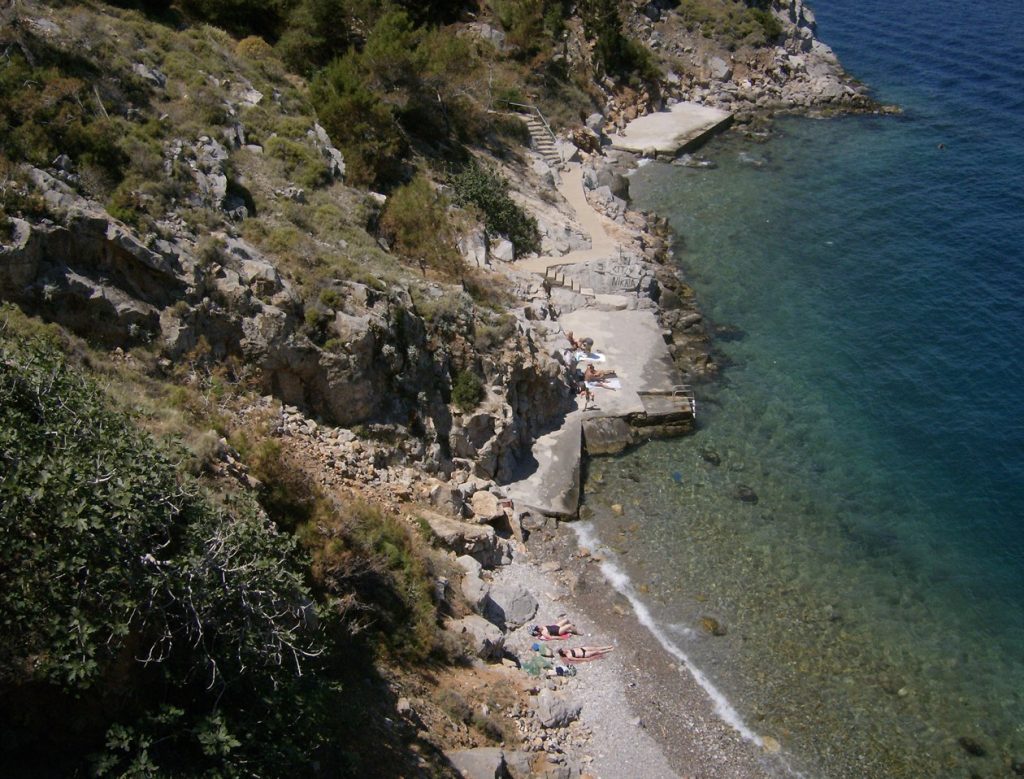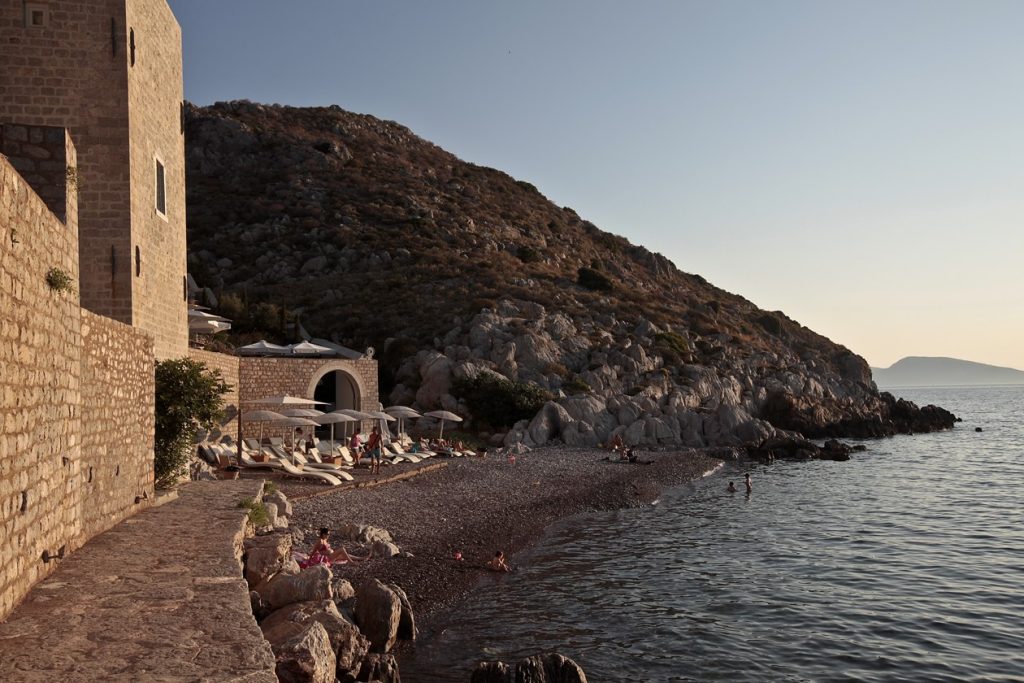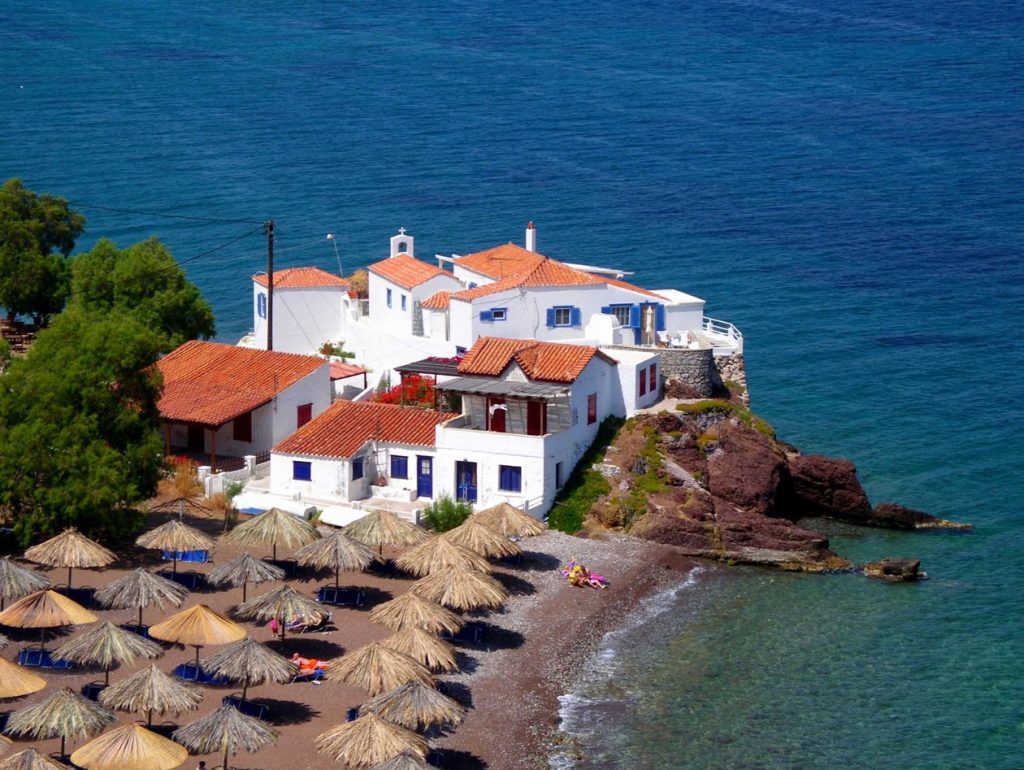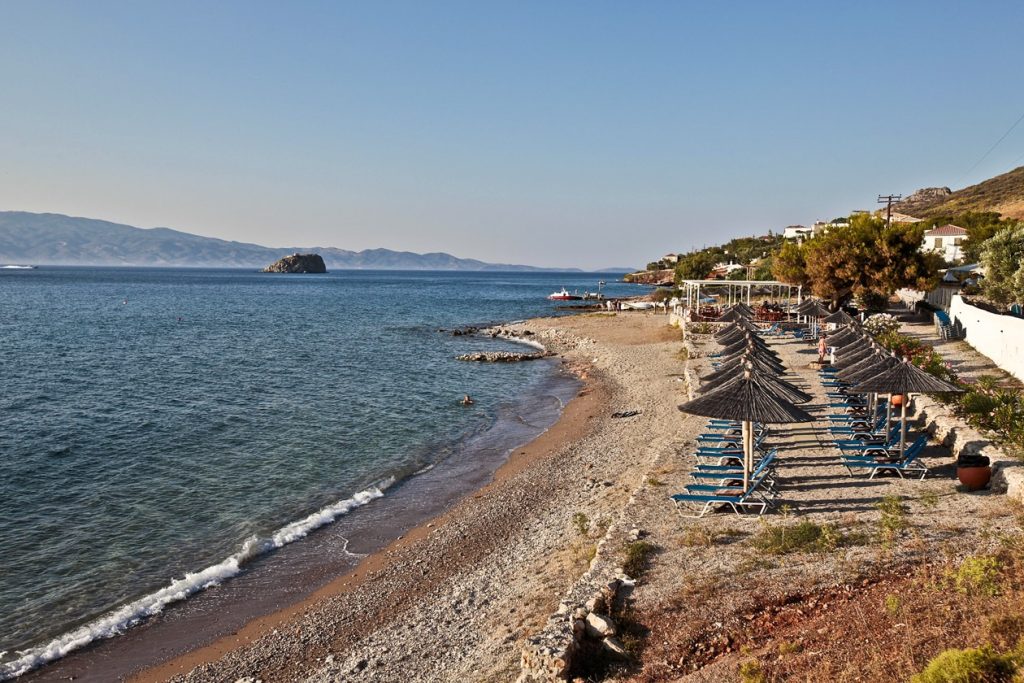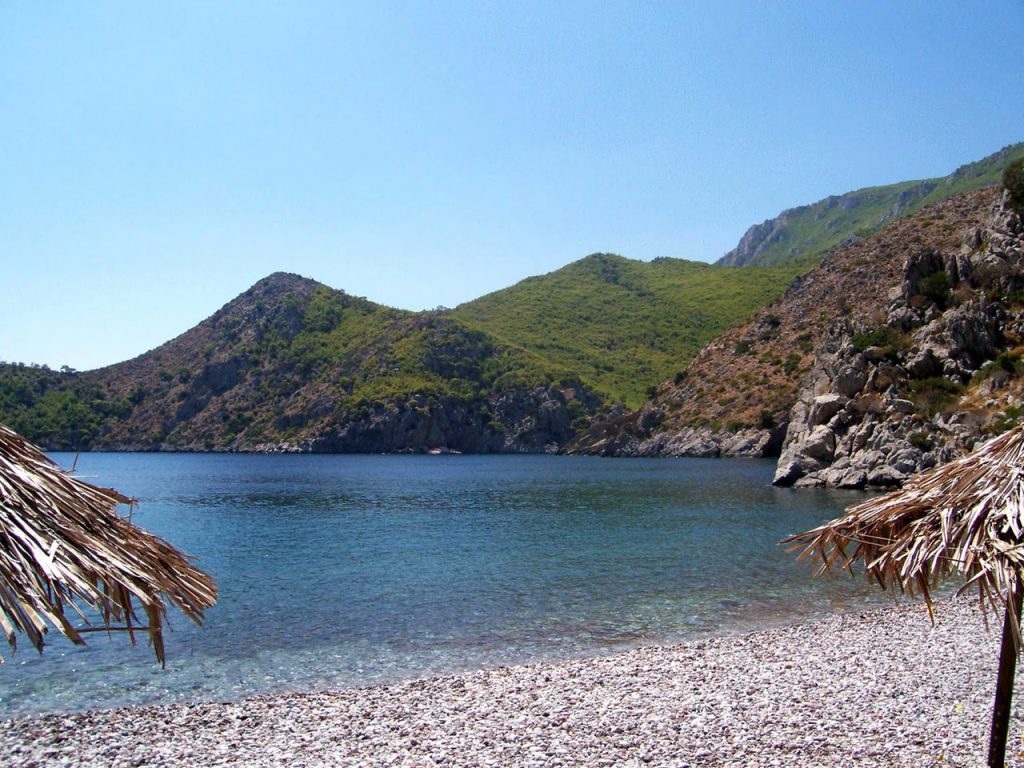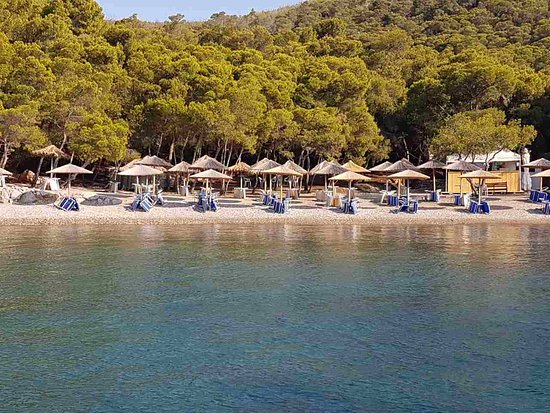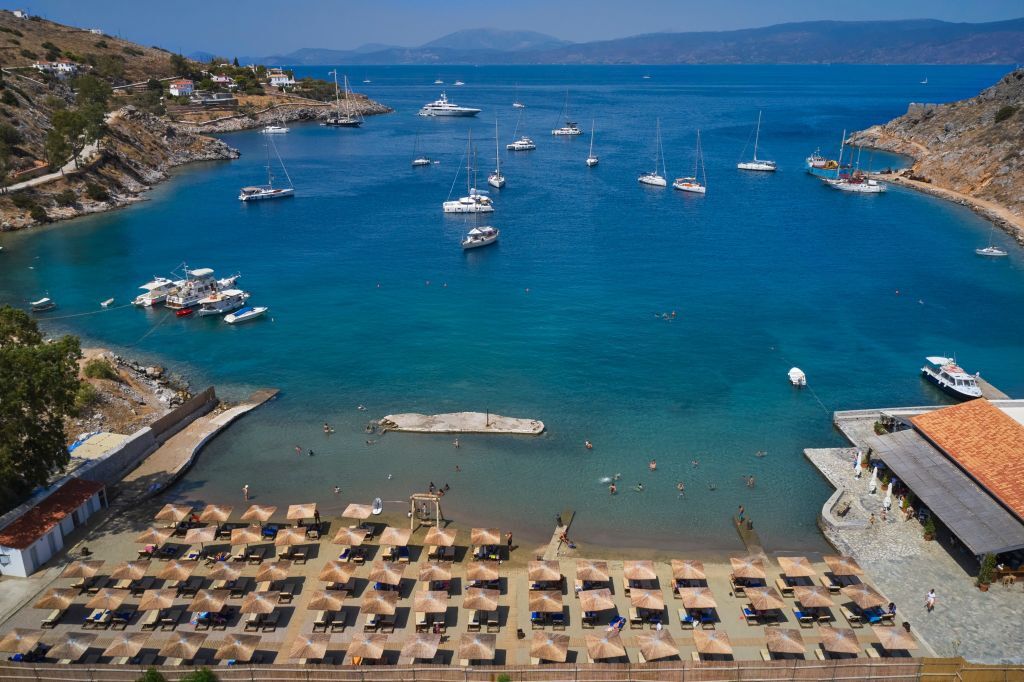The lacy beaches of Hydra, together with the “gray” of the rocks and the “blue” of the sea,
give Hydra a “wild” beauty
and make it an ideal place for inspiration and creativity...
Hydra, stately, glorious, and cosmopolitan, the jewel of the Saronic Gulf, has several beaches with sand, pebbles, or rocks. They can be accessed on foot, by donkey, or by sea. A common feature of all the beaches is their crystal clear, azure waters.
You can walk to Spilia, Hydroneta, and Avlaki, as they are located
just outside the port of Hydra.
At the end of the breakwater, on the rocks outside the harbor, lies Spilia, a rocky beach with intense activity, ideal for diving from the rocks into the very deep and crystal clear waters. Some rocks have been smoothed and covered with cement to create space for sunbathing. There is a café-snack bar where you can enjoy your coffee, an iced juice or soft drink, or a quick lunch.
Next to it is Hydroneta, located in perhaps the most beautiful part of the island, below the cannons, on the rocks, in the same area as the Cave. This is also ideal for diving from the rocks into the very deep waters. Here, too, there are sunbathing areas, as well as a café-snack bar where you can enjoy your coffee, an iced juice or soft drink, and a restaurant with unlimited sea views.
After Hydroneta is Avlaki, located between the old bridge of Agia Anna and the Bountouri Mansion. It is a beautiful little beach full of pebbles, which is illuminated at night, offering a wonderful sight. You descend some steps immediately after Ydroneta, and you will find green-blue waters and a pier where you can sunbathe.
All of the following beaches are connected to the port of Hydra by water taxi,
kaiki (traditional fishing boat), or small tourist boats.
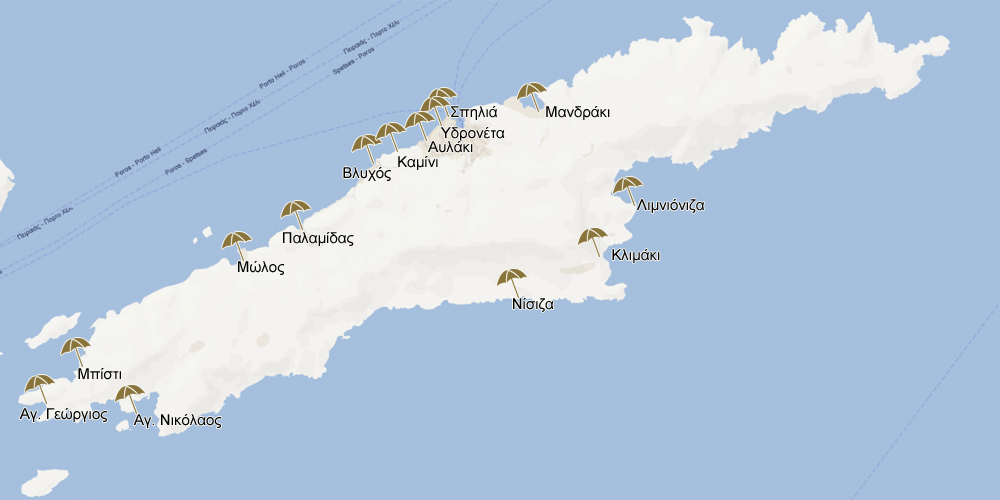
Following the coastal road, 10 minutes after Avlaki, we arrive at Kaminia, a small, natural, and picturesque fishing harbor full of fishing boats. In the small port of Kaminia, there is the old house of Miaoulis, the “red house” where various exhibitions are held every summer. Immediately after, we come across Mikro Kaminia, a beautiful, well-organized, small pebble beach with a beach bar, in “old Liotrivia,” one of the most popular spots on the island. Kaminia is ideal for family tourism.
Continuing along the dirt coastal road, after 10 minutes, we arrive at the beautiful traditional seaside village of Vlychos with its enchanting views and wonderful sunsets, which is also ideal for family tourism.
Whitewashed country houses with large flower-filled courtyards stretch to the foot of the hill above the beach. Among them stand out the picturesque seaside churches of Agios Charalambos on the plateau at the top of a rock rising from the sea, Agios Karpos and Papylos (1815) and Agia Paraskevi, which dominates the high sea-battered rock next to the beach, offering a unique spectacle of amazing beauty.
The organized picturesque beach of Vlychos with gray and reddish small pebbles and crystal clear waters, suitable for small children, is one of the most beautiful and popular beaches on the island. In Vlychos, there are wonderful picturesque seaside taverns serving fresh fish and traditional dishes.
After the small port of Vlychos, you will find the seaside settlement of Plakes Vlychos, a beautiful and well-organized beach with crystal clear blue waters. Just a few meters from the sea is the Four Seasons Hydra Hotel with a bar and restaurant.
Leaving Vlychos, after a 20-minute walk and passing a uniquely beautiful 17th-century bridge, we arrive at the coastal area of Palamida, a beautiful beach with sand and fine pebbles. There you will find the Voulgaris Mansion and the house where, according to history, Kapudan Pasha lived. Near the beach of Palamida there is a shipyard for the repair and maintenance of small and large boats.
A little further on, after the sharp rock of “Zastani,” is the deserted beach of Agios Kyprianos, with green-blue waters and the little church of Agios Kyprianos.
After Palamida is Molos, a secluded and fairly quiet rocky cove with a large and beautiful pebble beach. In the center of the beach is the old house of Charamis, and along the beach are the picturesque houses of the area, which are about a 70-minute walk from the town of Hydra. During the Greek Revolution of 1821, the bay of Molos served as a naval base for the ships of the rebellious Hydra.
A little further on, just past Molos, is a pine-covered area called Kaoumithi, which has an unorganized beach with coarse sand.
Continuing on, we find the beach of “Bali” or “Pigadakia” with small pebbles and warm waters that form a small harbor. A few meters from the sea, there is an ancient Protohelladic settlement.
Bisti is the southernmost bay on the island and is surrounded by high cliffs. It has an organized beach and is ideal for water sports, diving from the rocks, and spearfishing, next to a lush pine forest, where there is another ancient Protohelladic settlement.
The next beach, near Cape Bisti, on the west coast of the island, is the beautiful beach of Agios Georgios, quiet and unorganized, located between two pine-covered hills. The little church of Agios Georgios dominates the rocks above the beach.
Passing by the southwestern tip of the island, we come across the areas of “Paouki,” “Fichti” and reach the bay of Agios Nikolaos, at the end of which there is an organized beach with fine pebbles and crystal clear waters, with slopes covered with pine trees, suitable for underwater fishing. There are sunbeds with straw umbrellas and a canteen with small tables. A short distance from the coast, there are pine trees that provide shade and coolness. In addition, you will find areas with a little sand for small children to play. High above is the whitewashed chapel of “Agios Nikolaos” and next to it is the Mycenaean-Early Helladic settlement, an ancient water supply system, perhaps the oldest in Greece.
After Agios Nikolaos, passing the cape of “Agios Konstantinos,” just below Mount Gerakina and heading towards the southern side of Hydra, the steep coastline of the mountains of the Zogieri area comes into view, until we reach the cape of Agios Ioannis.
Then, the morphology of the area changes: the seascape calms down and the beautiful area of “Nisiza” appears before us. Nisiza is a pine-covered piece of land that juts out into the green-blue sea and creates two beautiful, unorganized pebble beaches to its right and left. The area was once the port of the ancient settlement of Episkopi.
After Nisiza is Klimaki, below the mountains “Eros” and “Pyrgos,” a large, unorganized beach with pebbles and crystal clear waters, where there are several holiday homes and the picturesque chapel of Agioi Taxiarches.
Continuing on, after the Cave of the Seal, the cape “Hunta tou Riga,” the beautiful “Bay of Riga,” and the cape “Tsigarí,” we find ourselves at the most beautiful beach on the southern coast of the island, Limnioníza. A pebble beach, unorganized, ideal for underwater fishing. Next to it is the lesser-known beach of Karali. Traces from the Early Helladic period have been found on the islet located on the beach of Limnioniza.
Completing our tour of Hydra, we pass by the steep southeastern coast of the island, which becomes wilder and more rugged. Starting from “Hounta Zeza,” we pass through the area of “Piochi,” the area of “Pentevolia” in the bay of Avlaki, the bay of “Zougou,” and finally arrive at the cape of Zoubra.
After Cape Zoubra, we head north and come across the bay of “Zoodochos Pigi,” at the end of which lies the area of “Nero,” where for many millennia water has been dripping from a rock, giving the area its name. On the hill stands the whitewashed chapel of Zoodochos Pigi, and on the steep rock of “Nero” are the ruins of an ancient settlement.
Passing Cape Hounda Dosa and Cape Bretista, we arrive at the bay of Ledeza, the port of Zourva, from where the ascent to the Holy Monastery of the Birth of the Virgin Mary begins.
Continuing on, we arrive at the area of “Kasteva,” which forms two sea bays, one larger on the west side and another smaller one on the east. Next comes the area of Marouleza, famous for its sage bushes, and then Kritami, a natural harbor where the aromatic plant kritami grows.
Finally, we reach the last cove before the port of Hydra, Mandraki, the island’s old military port, whose entrance was once guarded by two small castles filled with cannons.
Mandraki has a beautiful, well-organized sandy beach, the only one in Hydra without pebbles, located about 20 minutes from the island’s port. You can reach it either on foot or by boat from the port of Hydra.
Moving on from Mandraki, we come across the areas of Kamaritsa, Podaraki tou Christou, Gourna, and then we arrive at the lighthouse located in the port of Hydra.

